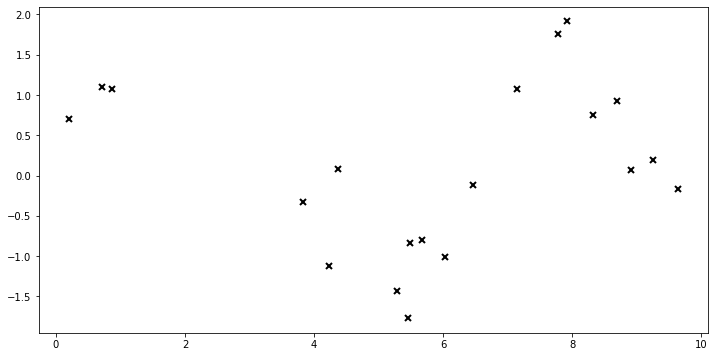Sanity checking when model behaviours should overlap#
Many of the model classes in GPflow have overlapping behaviour in special cases. In this notebook, we fit some approximations to a model with a Gaussian likelihood, and make sure they’re all the same.
The models are: - GPR: Full Gaussian process regression.
VGP: A Gaussian approximation with Variational Bayes. Approximating a Gaussian posterior with a Gaussian should be exact.SVGP: a sparse GP, with a Gaussian approximation. The inducing points are set to be at the data points, so again, should be exact.SVGP(with whitened representation): As above, but with a rotation applied to whiten the representation of the process.SGPR: A sparse GP with a collapsed posterior (Titsias 2009). Again, the inducing points are fixed to the data points.GPRFITC: The FITC approximation. Again, the inducing points are fixed to the data points.
In all cases the parameters are estimated by the method of maximum likelihood (or approximate maximum likelihood, as appropriate). The parameter estimates should all be the same.
[1]:
import gpflow
import numpy as np
import tensorflow as tf
import matplotlib.pyplot as plt
from gpflow import set_trainable
from gpflow.models import maximum_log_likelihood_objective, training_loss_closure
from gpflow.config import default_float
from gpflow.ci_utils import ci_niter
%matplotlib inline
plt.rcParams["figure.figsize"] = (12, 6)
2022-05-10 11:28:40.611747: W tensorflow/stream_executor/platform/default/dso_loader.cc:64] Could not load dynamic library 'libcudart.so.11.0'; dlerror: libcudart.so.11.0: cannot open shared object file: No such file or directory
2022-05-10 11:28:40.611775: I tensorflow/stream_executor/cuda/cudart_stub.cc:29] Ignore above cudart dlerror if you do not have a GPU set up on your machine.
[2]:
np.random.seed(0)
X = np.random.rand(20, 1) * 10
Y = np.sin(X) + 0.9 * np.cos(X * 1.6) + np.random.randn(*X.shape) * 0.4
Xtest = np.random.rand(10, 1) * 10
_ = plt.plot(X, Y, "kx", mew=2)

[3]:
data = (
tf.convert_to_tensor(X, dtype=default_float()),
tf.convert_to_tensor(Y, dtype=default_float()),
)
inducing_variable = tf.convert_to_tensor(X, dtype=default_float())
m1 = gpflow.models.GPR(data, kernel=gpflow.kernels.SquaredExponential())
m2 = gpflow.models.VGP(
data, kernel=gpflow.kernels.SquaredExponential(), likelihood=gpflow.likelihoods.Gaussian()
)
m3 = gpflow.models.SVGP(
gpflow.kernels.SquaredExponential(),
gpflow.likelihoods.Gaussian(),
inducing_variable,
q_diag=False,
)
set_trainable(m3.inducing_variable, False)
m4 = gpflow.models.SVGP(
gpflow.kernels.SquaredExponential(),
gpflow.likelihoods.Gaussian(),
inducing_variable,
q_diag=False,
whiten=True,
)
set_trainable(m4.inducing_variable, False)
m5 = gpflow.models.SGPR(
data, kernel=gpflow.kernels.SquaredExponential(), inducing_variable=inducing_variable
)
set_trainable(m5.inducing_variable, False)
m6 = gpflow.models.GPRFITC(
data, kernel=gpflow.kernels.SquaredExponential(), inducing_variable=inducing_variable
)
set_trainable(m6.inducing_variable, False)
models = [m1, m2, m3, m4, m5, m6]
2022-05-10 11:28:43.574738: W tensorflow/stream_executor/platform/default/dso_loader.cc:64] Could not load dynamic library 'libcuda.so.1'; dlerror: libcuda.so.1: cannot open shared object file: No such file or directory
2022-05-10 11:28:43.574771: W tensorflow/stream_executor/cuda/cuda_driver.cc:269] failed call to cuInit: UNKNOWN ERROR (303)
2022-05-10 11:28:43.574788: I tensorflow/stream_executor/cuda/cuda_diagnostics.cc:156] kernel driver does not appear to be running on this host (49c966262641): /proc/driver/nvidia/version does not exist
2022-05-10 11:28:43.575061: I tensorflow/core/platform/cpu_feature_guard.cc:151] This TensorFlow binary is optimized with oneAPI Deep Neural Network Library (oneDNN) to use the following CPU instructions in performance-critical operations: AVX2 AVX512F FMA
To enable them in other operations, rebuild TensorFlow with the appropriate compiler flags.
2022-05-10 11:28:43.655743: W tensorflow/python/util/util.cc:368] Sets are not currently considered sequences, but this may change in the future, so consider avoiding using them.
Now, we optimize the models. For GPR, SVGP, and GPRFITC, this simply optimizes the hyperparameters (since the inducing points are fixed). For the variational models, this jointly maximises the lower bound to the marginal likelihood (Evidence Lower Bound, ELBO) with respect to the variational parameters and the kernel and likelihood hyperparameters.
[4]:
for m in models:
opt = gpflow.optimizers.Scipy()
loss_closure = training_loss_closure(m, data)
opt.minimize(
loss_closure,
variables=m.trainable_variables,
options=dict(maxiter=ci_niter(1000)),
compile=True,
)
If everything worked as planned, the models should have the same:
prediction functions
log (marginal) likelihood
kernel parameters
For the variational models, where we use a ELBO in place of the likelihood, the ELBO should be tight to the likelihood in the cases studied here.
[5]:
def plot(m, color, ax):
xx = np.linspace(-1, 11, 100)[:, None]
mu, var = m.predict_y(xx)
ax.plot(xx, mu, color, lw=2)
ax.fill_between(
xx[:, 0],
mu[:, 0] - 2 * np.sqrt(var[:, 0]),
mu[:, 0] + 2 * np.sqrt(var[:, 0]),
color=color,
alpha=0.2,
)
ax.plot(X, Y, "kx", mew=2)
ax.set_xlim(-1, 11)
f, ax = plt.subplots(3, 2, sharex=True, sharey=True, figsize=(12, 9))
plot(m1, "C0", ax[0, 0])
plot(m2, "C1", ax[1, 0])
plot(m3, "C2", ax[0, 1])
plot(m4, "C3", ax[1, 1])
plot(m5, "C4", ax[2, 0])
plot(m6, "C5", ax[2, 1])

Here are the kernels and likelihoods, which show the fitted kernel parameters and noise variance:
[6]:
for m in models:
print(m.__class__.__name__)
print(f" kernel lengthscale = {m.kernel.lengthscales.numpy():.5g}")
print(f" kernel variance = {m.kernel.variance.numpy():.5}")
print(f" likelihood variance = {m.likelihood.variance.numpy():.5}")
GPR
kernel lengthscale = 1.0774
kernel variance = 0.82561
likelihood variance = 0.16002
VGP
kernel lengthscale = 1.0773
kernel variance = 0.82546
likelihood variance = 0.16002
SVGP
kernel lengthscale = 1.0774
kernel variance = 0.82549
likelihood variance = 0.16003
SVGP
kernel lengthscale = 1.0774
kernel variance = 0.82549
likelihood variance = 0.16003
SGPR
kernel lengthscale = 1.0774
kernel variance = 0.82561
likelihood variance = 0.16002
GPRFITC
kernel lengthscale = 1.0774
kernel variance = 0.82561
likelihood variance = 0.16002
Here are the likelihoods (or ELBOs):
[7]:
for m in models:
print(f"{m.__class__.__name__:30} {maximum_log_likelihood_objective(m, data)}")
GPR -18.83436136005666
VGP -18.83436154110053
SVGP -18.834400091462825
SVGP -18.834400091462825
SGPR -18.834399989062106
GPRFITC -18.834354780715664